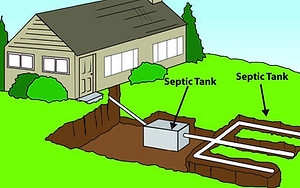
SEPTIC SYSTEMS
Bay Shore can handle all your septic engineering needs on your commercial, business, or residential projects. We have engineers that will come out and verify soil types, set backs, and restrictive area to state, county and city and county guidelines to come up with the most efficient On Site Sewage System to install design and maintain. Using one company for the whole septic design and install saves you time and money. Our engineering services always include all the permit submitting, calculations, paperwork and record drawings so you can rest assured Bay Shore Construction always handles the whole process as a turn key service. Give us a call with your septic needs.

Septic Drain Fields
Septic Drain Fields are used to remove contaminants and impurities from the liquid that emerges from the septic tank. This is typically done by burying perforated pipes in trenches and allowing the liquid to leach out into the surrounding soil which absorbs the unwanted waste. Another term for this is “leach field”. The design of the septic drain field is determined by the size of the dwelling that it serves and the soil conditions. The soil conditions are tested by a method called a “percolation test” or “perc test”. An engineer or licensed designer may be required to work with the local governing agency to design a system that conforms to these criteria.

Sand Mound System
These systems are used in areas where the site is not suitable for traditional septic systems. For instance, the soil may have too much clay to allow the water to seep through at the proper rate, or the water table may be too close to the ground surface. In these systems, the waste water flows from the septic tank to a storage tank. The liquid is then pumped from the tank to perforated plastic pipes buried in a mound of sand built on the original soil surface. This system provides a layer of suitable soil thick enough to ensure adequate time and distance for proper treatment of the waste water. Vegetation growing on the mound helps to evaporate some of the liquid. This is particularly important in areas with shallow water tables.

Pressure Distribution
This system has a pump that distributes wastewater evenly throughout the drainage field. The pump tank holds wastewater until a certain point, then releases it into the drainage field. Pressure distribution systems are normally used when there is not enough soil depth to accommodate gravity based systems.

Gravity System
One of the first types of septic systems use gravity to drain waste water from the tank into a series of trenches. Because this system works using gravity, the drainage field must be below the level of the septic tank. Also, the bottom of the trenches must be three or four feet above the water table. This soil above the water table is used to treat the wastewater before it returns to the environment.

Sand Filter System
These are one of the most common types of septic systems. This system uses sand between the pump tank and the drainage field to treat the wastewater before it enters the field. These types of septic systems are used when the soil is very shallow. Treating the wastewater with sand makes up for the lack of soil that would normally be used to treat the waste.


